MaryAnn Bernal's Blog, page 174
May 27, 2015
Staffordshire hoard: experts piece together rare warrior's helmet
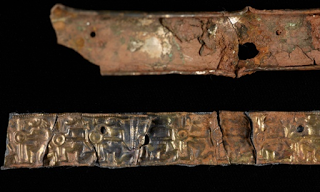 A reconstructed helmet band, depicting a frieze of warriors, which was found as part of the Staffordshire hoard. Photograph: Birmingham museums trust/PA Anglo-Saxon headgear reconstructed from more than 1,500 pieces as £400,000 grant is announced to fund further work on the treasure
A reconstructed helmet band, depicting a frieze of warriors, which was found as part of the Staffordshire hoard. Photograph: Birmingham museums trust/PA Anglo-Saxon headgear reconstructed from more than 1,500 pieces as £400,000 grant is announced to fund further work on the treasureThe Guardian
More than 1,500 scraps of silver gilt foil from the Staffordshire hoard of Anglo-Saxon treasure, including strips stamped with designs of warriors and beasts and other fragments the size of a fingernail, are being pieced together by archaeologists and conservators into a warrior’s helmet of international importance – as it is one of only five ever found.
With years of conservation and research remaining, Historic England will announce a £400,000 grant on Tuesday to fund the continuing study of the largest hoard of Anglo Saxon precious metal work ever found. It was discovered by a metal detector in 2010 in Staffordshire farmland before another 90 pieces were recovered from the same field three years later.
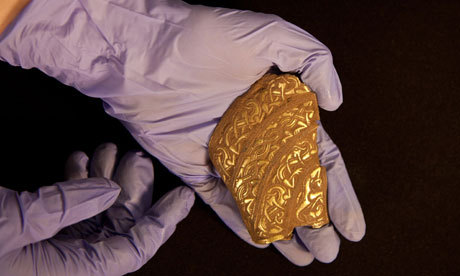 Staffordshire hoard site yields further 90 fragments Gold and garnet cross and eagle-shaped mount among latest items unearthed by archaeologists in Hammerwich field Birmingham and Stoke-on-Trent councils, joint owners of the hoard, are trying to raise an additional £120,000 towards the project, which will include an online catalogue of the complete hoard by 2017.
Staffordshire hoard site yields further 90 fragments Gold and garnet cross and eagle-shaped mount among latest items unearthed by archaeologists in Hammerwich field Birmingham and Stoke-on-Trent councils, joint owners of the hoard, are trying to raise an additional £120,000 towards the project, which will include an online catalogue of the complete hoard by 2017.“Until we started fitting the pieces together we weren’t even quite sure that we had a helmet, but we are now certain that we have most of it,” said Pieta Greaves, coordinator of the conservation team at the Birmingham museum. “We are missing some pieces including the iron frame, but we should end up with an academically respectable guestimate of what it could have looked like. I think some form of reconstruction will prove feasible.”
The helmet would have dazzled when new, set with bands of precious metal and golden intricately decorated pieces covering the ears.
“We’re missing bits that we see on the Sutton Hoo helmet, like the eyebrow and face protectors, but we have the ear pieces, most of the cap and the crest. What we have is the valuable bits, the stripped out silver and gold – it may be that somebody else got a bag full of base metal to melt down,” Greaves said.
The hoard is unique in that it consists entirely of male ornament and decorative weapon fittings – “warrior bling” as one archaeologist put it – and a few Christian pieces that may have been wrenched off bibles or reliquaries. Among more than 4,000 pieces nothing has been identified that was made for a woman.
 A detail of the front of the reconstructed sword pommel. Photograph: Birmingham Museums Trust/PA The meticulous cleaning and study of even the tiniest pieces has also identified a unique sword pommel, which was among more than 70 examples in the hoard, that combines Irish and British styles, and materials including gold, silver, garnet, glass and deliberately blackened silver niello work.
A detail of the front of the reconstructed sword pommel. Photograph: Birmingham Museums Trust/PA The meticulous cleaning and study of even the tiniest pieces has also identified a unique sword pommel, which was among more than 70 examples in the hoard, that combines Irish and British styles, and materials including gold, silver, garnet, glass and deliberately blackened silver niello work.AdvertisementChris Fern, the project archaeologist, said the skill of the workmanship was thrilling and the pommel a truly exciting object. “It combines multiple different styles of ornament, much in the same way as the earliest seventh-century illuminated manuscripts do, like the Book of Durrow. It suggests the coming together of Anglo-Saxon and British or Irish high cultures.”
Greaves said the pommel was the only piece to combine so many materials: “It’s as if the craftsman was showing off, saying look at me, look at what I can really do.”
The gallery for the hoard opened in October by Birmingham city museum has had more than 110,000 visitors. Duncan Wilson, chief executive of Historic England, said: “Since its discovery in 2009, the Staffordshire hoard and the stories behind it have captured the public imagination.”
Published on May 27, 2015 08:39
History Trivia - Procopius executed
May 27,

366 Procopius, Roman usurper against Valens, and member of the Constantinian dynasty was executed.
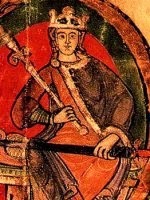
1153 Malcolm IV became King of Scotland.

1564 John Calvin, one of the dominant figures of the Protestant Reformation, died in Geneva.

366 Procopius, Roman usurper against Valens, and member of the Constantinian dynasty was executed.

1153 Malcolm IV became King of Scotland.

1564 John Calvin, one of the dominant figures of the Protestant Reformation, died in Geneva.
Published on May 27, 2015 00:30
May 26, 2015
Did Lady Godiva ride naked in Coventry?
 Lady Godiva sculpture by J Thomas, 1861. (Photo by Universal History Archive/UIG via Getty Images)
Lady Godiva sculpture by J Thomas, 1861. (Photo by Universal History Archive/UIG via Getty Images) History Extra
In legend, Lady Godiva was willing to ride naked through the streets of Coventry to persuade her husband to lower taxes – but did it actually happen?
This article was first published in the May 2015 issue of History Revealed
The naked truth of the matter is that: no, she didn’t. Lady Godifu (or Godgyfu) was a real woman and she was married to one of the wealthiest men in Anglo-Saxon England, Earl Leofric of Mercia.
Less famously, the pair were generous patrons of monasteries, and Godifu (which should actually be pronounced Gud-geef-uh), in particular donated much gold and silver to make crucifixes.
Despite both dying roughly around the time of 1066, the story of her naked ride through Coventry was first recorded by the chronicler Roger of Wendover in the 1200s, so isn’t considered reliable by historians.
Indeed, Wendover only says Leofric offered to lower taxes on the poor if his wife mounted her horse in the nude, but he doesn’t make clear if she went through with it.
Nevertheless, the tale became well-known, and in the 1600s, the extra element of Peeping Tom – who leered at her body while the townspeople respectfully shut their eyes – was added for an extra bit of juicy drama.
Answered by one of our Q&A experts, Greg Jenner. For more fascinating questions by Greg, and the rest of our panel, pick up a copy of History Revealed! Available in print and for digital devices.
Published on May 26, 2015 06:28
Dark Side of Medieval Convent Life Revealed
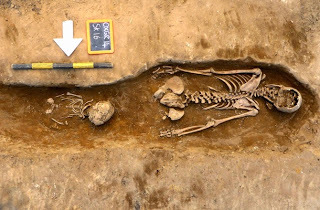 The skeleton of a sinner woman buried in face down. Her lower legs had been truncated by a later burial of an infant.Discovery News
The skeleton of a sinner woman buried in face down. Her lower legs had been truncated by a later burial of an infant.Discovery Newsby Rossella Lorenzi
British archaeologists excavating a church site in Oxford have brought to light the darker side of medieval convent life, revealing skeletons of nuns who died in disgrace after being accused of immoral behavior.
Discovered ahead of the construction of a new hotel, the burial ground stretches around what used to be Littlemore Priory, a nunnery founded in 1110 and dissolved in 1525.
Archaeologists led by Paul Murray, of John Moore Heritage Services, found 92 skeletons of women, men and children.3,000 Skeletons Recovered at London Train Station Site
“Burials within the church are likely to represent wealthy or eminent individuals, nuns and prioresses,” Murray said in a statement.
“Those buried outside most likely represent the laity and a general desire to be buried as close to the religious heart of the church as possible,” he added.
Females made up the majority of the burials, at 35, with males accounting for 28; it was impossible to determine the gender of the remaining 29.
Among the burials, the archaeologists unearthed a female aged 45 or more who was likely one of the 20 women who held the position of prioress throughout the history of the priory.
She was interred at the exact center of the crossing in a well constructed stone coffin, with a head niche.
Some skeletons showed signs of debilitating ailments, such as two children who suffered from developmental dysplasia of the hip.
Photos: Skeletons of Scholars Found in Cambridge
“This would have a resulted in reduced length of the leg and therefore a severe limp and perhaps needing the use of a crutch,” Murray said.A single burial possibly had leprosy, while another skeleton showed signs of a blunt force trauma to the skull, likely the cause of death.
Other unusual burials included a stillborn baby in a well-made casket, and a woman buried in a face down position.
“This was perhaps a penitential act to atone for her sins,” Murray said.
The woman may have been one of the sinner nuns Cardinal Wolsey accused of immoral behavior when he closed down the nunnery.
Indeed, the last prioress, Katherine Wells (1507 and 1518) was deposed of the position as punishment for a number of misdeeds, such as giving birth to an illegitimate child fathered by a priest from Kent, and stealing things belonging to the monastery — pots, pens and candlesticks, etc. — to provide a dowry for her daughter.
According to accounts taken after bishop Atwater’s visitation in 1517 an 1518, another nun had an illegitimate child by a married man of Oxford.
Medieval ‘Witch Girl’ Likely Just Suffered From Scurvy
Life at the nunnery could be severe, records show, with the prioress often putting the nuns into the stocks and beating them “with fists and feet.”When in 1518, the bishop visited the nunnery again, the prioress complained that one of the nuns “played and romped” with boys in the cloister and refused to be corrected.
The story goes that when the nun was put in the stocks she was rescued by three other nuns who broke down the door, burnt the stocks and broke a window to escape to friends where they remained for two or three weeks.
Wells appears to have regained her position later in 1518 as no other prioresses are recorded after this date. It is likely she remained at the priory for a further seven years until its dissolution in 1525.
According to Murray, the bishop reports are certainly tainted to at least some degree and were used to justify Cardinal Wolsey’s desire to dissolve the nunnery and use its revenues to fund Cardinal’s College, now Christ Church, traditionally considered one of Oxford’s most aristocratic colleges.
“The complaints made about the nuns when they ‘played and romped’ with boys in the cloister and their refusal to be corrected, perhaps reveals something about the nuns caring nature and an element of free spirit,” he added.
Photos: Mummy Stash Found in Italian ChurchEvidence for the caring, nursing element of the priory is also provided by the remains of the children with debilitating illnesses and the leprosy sufferer.
“They were not just nuns, but business women, educators, care givers and mothers. They coped as best they could with the trials of daily life, although one could imagine they found time to enjoy it too,” Murray said.
Turned into a farmhouse after the nunnery’s dissolution, the priory might be incorporated into the new hotel as a restaurant.
Researchers at Reading University are now undertaking isotope analysis to learn more about the origin and diet of the people buried in the church.
The skeletal remains will eventually be reburied on consecrated ground.
Published on May 26, 2015 06:22
History Trivia - Germanicus returns to Rome
May 26,

17 Germanicus returned to Rome as a conquering hero; he celebrated a triumph for his victories over the Cherusci, Chatti and other German tribes west of the Elbe.

451 Battle of Avarayr between Armenian rebels and the Sassanid Empire took place. The Empire defeated the Armenians militarily but guaranteed them freedom to openly practice Christianity.

604 St Augustine died. The Benedictine monk became the first Archbishop of Canterbury in the year 597. He is considered the "Apostle to the English" and a founder of the English Church.

17 Germanicus returned to Rome as a conquering hero; he celebrated a triumph for his victories over the Cherusci, Chatti and other German tribes west of the Elbe.

451 Battle of Avarayr between Armenian rebels and the Sassanid Empire took place. The Empire defeated the Armenians militarily but guaranteed them freedom to openly practice Christianity.

604 St Augustine died. The Benedictine monk became the first Archbishop of Canterbury in the year 597. He is considered the "Apostle to the English" and a founder of the English Church.
Published on May 26, 2015 01:00
May 25, 2015
Frozen in Time: Casts of Pompeii Reveal Last Moments of Volcano Victims
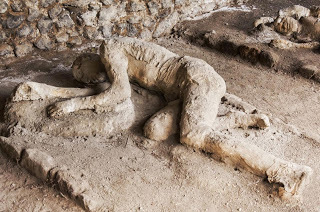 Ancient Origins
Ancient OriginsThe plaster casts of 86 agonized victims of the Mount Vesuvius eruption in 79 AD will go on exhibit May 26, 2015, in National Archaeological Museum of Naples, Italy.
People of Pompeii, a Roman city, were in their death throes when a cloud of gas from the volcano enveloped them, killing them. The gas was 300 degrees centigrade (572 degrees F). Clearly, from the expressions of their faces and their bodily contortions they were caught by surprise when the ash cloud finally consumed them.
An article on ANSA.com states:
Teeth protrude from lips stretched from pain. Smoldering, encrusted skin, protruding skulls and bones, exposed jaws were all caught in the moment of death, when a glowing, 300C cloud seared surfaces of the bodies in a single stroke, leaving their insides soft, and burying them under ash and stones. Among them is the family of the House of the Golden Bracelet: a woman with a baby on her lap. Near her is a man and another child, perhaps two years old.
 Harrowing image shows a child sitting on his mother when the ash cloud hit. Credit: Splash NewsThe actual bodies, which were ossified by the heat, will not go on display but rather the plaster casts that show the exact position the bodies were found in.
Harrowing image shows a child sitting on his mother when the ash cloud hit. Credit: Splash NewsThe actual bodies, which were ossified by the heat, will not go on display but rather the plaster casts that show the exact position the bodies were found in.Massimo Osanna, the superintendent of archaeology in Pompeii and nearby towns said: "Until now they had never been surveyed, out of a sense of ethics with which these human remains were always treated. No statues of plaster or bronze, but real people who should be treated with respect.”
 Some of the victims of volcanic gas cloud were clearly in agony (Bigstock photo)Archaeologist Giuseppe Fiorelli found the bodies in 1863 and came up with a way to detect and extract the bodies intact from their resting places in Pompeii. Scientists also found animals, including a dog and a pig, but they won't be on display in the museum. The animals were restored for purposes of archaeology and science, Osanna said.
Some of the victims of volcanic gas cloud were clearly in agony (Bigstock photo)Archaeologist Giuseppe Fiorelli found the bodies in 1863 and came up with a way to detect and extract the bodies intact from their resting places in Pompeii. Scientists also found animals, including a dog and a pig, but they won't be on display in the museum. The animals were restored for purposes of archaeology and science, Osanna said.A team of scientists, including archaeologists, engineers, an anthropologist, restoration experts and radiologists, is undertaking the Great Pompeii Project to do anthropological and genetic profiling of the unfortunate victims of the eruption. The scientists hope to get a better understanding of their way of life and identify them more fully. They will publish their findings and be featured in a documentary by a restoration company from Salerno.
Pompeii was a flouring Roman city from the 6th century BC until it became frozen in time, preserved by the layers of ash that spewed out from the great eruption of Mount Vesuvius in the 1st century AD. Although Pompeii was initially rediscovered at the end of the 16th century, it was only properly excavated in the 18th century. Excavators were startled by the sexually explicit frescoes they were unearthing, quite shocking to the sensibilities of medieval citizens of Rome, so they quickly covered them over.
 Raunchy frescoes uncovered in Pompeii. Source: BigStockPhotoWhen excavations resumed nearly two centuries later, archaeologists found the city almost entirely intact – loaves of bread still sat in the oven, bodies of men, women, children, and pets were found frozen in their last moments, the expressions of fear still etched on their faces, and the remains of meals remained discarded on the pavement. The astounding discovery meant that researchers could piece together exactly what life was like for the ancient Romans of Pompeii – the food they ate, the jobs they performed and the houses they lived in
Raunchy frescoes uncovered in Pompeii. Source: BigStockPhotoWhen excavations resumed nearly two centuries later, archaeologists found the city almost entirely intact – loaves of bread still sat in the oven, bodies of men, women, children, and pets were found frozen in their last moments, the expressions of fear still etched on their faces, and the remains of meals remained discarded on the pavement. The astounding discovery meant that researchers could piece together exactly what life was like for the ancient Romans of Pompeii – the food they ate, the jobs they performed and the houses they lived in.
 The city of Pompeii (Bigstock photo)Photos of researchers working with the bodies and making plaster casts may be viewed at The Daily Mail.
The city of Pompeii (Bigstock photo)Photos of researchers working with the bodies and making plaster casts may be viewed at The Daily Mail.Featured image: Some of the victims of Pompeii were sitting, some lying when the superhot gas cloud enveloped them. (Bigstock photo)
By Mark Miller
Published on May 25, 2015 07:22
Memorial Day 2015: A Day to Remember the sacrifices of our Armed Forces

Wikipedia
Memorial Day is a federal holiday in the United States for remembering the people who died while serving in the country's armed forces. The holiday, which is observed every year on the last Monday of May, was formerly known as Decoration Day and originated after the American Civil War to commemorate the Union and Confederate soldiers who died in the war. By the 20th century, Memorial Day had been extended to honor all Americans who died while in the military service It typically marks the start of the summer vacation season, while Labor Day marks its end.
Many people visit cemeteries and memorials, particularly to honor those who have died in military service. Many volunteers place an American flag on each grave in national cemeteries.
Published on May 25, 2015 04:30
History Trivia - The Venerable Bede dies
May 25,

585 BC Thales of Greece made the first known prediction of a solar eclipse.

735 The Venerable Bede died.

946 Edmund the Older, king of Wessex/England (939-46), died.

585 BC Thales of Greece made the first known prediction of a solar eclipse.

735 The Venerable Bede died.

946 Edmund the Older, king of Wessex/England (939-46), died.
Published on May 25, 2015 00:00
May 24, 2015
History Trivia - Fifth Crusade leaves Acre for Egypt
May 24,

1218 The Fifth Crusade left Acre for Egypt.

1337 The Hundred Years War between England and France began when France confiscated Gascony from Edward III.

1487 The ten-year-old Lambert Simnel was crowned in Christ Church Cathedral in Dublin, Ireland with the name of Edward VI in a bid to threaten King Henry VII's reign.

1218 The Fifth Crusade left Acre for Egypt.

1337 The Hundred Years War between England and France began when France confiscated Gascony from Edward III.

1487 The ten-year-old Lambert Simnel was crowned in Christ Church Cathedral in Dublin, Ireland with the name of Edward VI in a bid to threaten King Henry VII's reign.
Published on May 24, 2015 00:30
May 23, 2015
History Trivia - Joan of Arc captured
May 23,

1275 King Edward I of England ordered the cessation of persecution of French Jews.

1430 Joan of Arc was captured at Compiegne and sold to the British.

1533 The marriage of King Henry VIII to Catherine of Aragon was declared null and void.

1275 King Edward I of England ordered the cessation of persecution of French Jews.

1430 Joan of Arc was captured at Compiegne and sold to the British.

1533 The marriage of King Henry VIII to Catherine of Aragon was declared null and void.
Published on May 23, 2015 02:00



